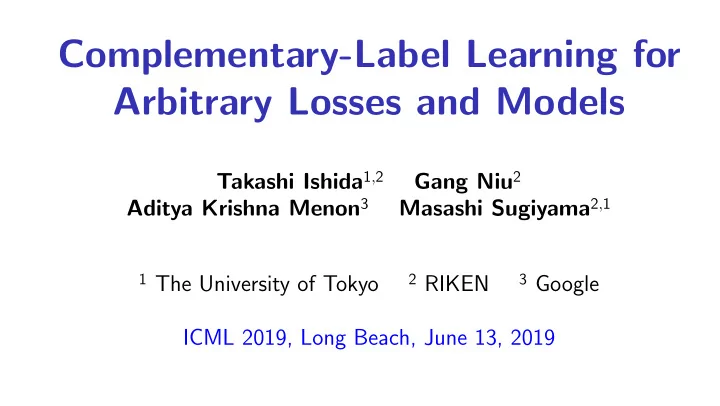

Complementary-Label Learning for Arbitrary Losses and Models Takashi Ishida 1 , 2 Gang Niu 2 Aditya Krishna Menon 3 Masashi Sugiyama 2 , 1 1 The University of Tokyo 2 RIKEN 3 Google ICML 2019, Long Beach, June 13, 2019
Classify Robot images into 100 classes! www.bostondynamics.com/robots , www.kisspng.com/png-nao-humanoid-robot-robotics-pepper-robots-716455/ , japanese.engadget.com/2017/11/03/aibo/ , www.sankei.com/economy/photos/160408/ecn1604080030-p4.html gpad.tv/develop/sharp-robohon-browser-program-tool-sr-b04at/ , www.uni-info.co.jp/news/2017/0118_2.html 2 / 10 www.theverge.com/2014/2/4/5378874/sonys-new-aibo-is-a-french-bulldog-named-boss , https://zenbo.asus.com/
What is the name of this robot? 3 / 10
The difficulty of labeling images 4 / 10
5 / 10
6 / 10
Goal of Our Paper ∎ Can we train with only complementary labels? → Yes! ▸ Ishida, Niu, Hu, & Sugiyama [NeurIPS 2017] ▸ Yu, Liu, Gong, & Tao [ECCV 2018] � However, previous works on complementary-label learning, → had restrictions on losses, → had restrictions on models, → or did not derive an unbiased estimator ∎ We propose an unbiased classification risk estimator for complementary-label learning for arbitrary losses and models! 7 / 10
Main Idea ∎ Regard complementary-label learning as a noisy-label problem and apply noise correction! ▸ Cid-Sueiro, Garc´ ıa-Garc´ ıa, & Santos-Rodr´ ıguez [ECML-PKDD 2014] ▸ Natarajan, Dhillon, Ravikumar, & Tewari [NeurIPS 2013] → Complementary labels are noisy labels with uniform transition from other (true) classes 8 / 10
Main Discovery ∎ Unbiased risk estimation is possible w/o loss/model restrictions: E p ( x , y ) [ ℓ ( y , g ( x ))] = E p ( x , y ) [ − ( K − 1 ) ⋅ ℓ ( y , g ( x )) + ∑ K j = 1 ℓ ( j , g ( x ))] ▸ Assumption: p ( y ∣ x ) = ∑ y ≠ y p ( y ∣ x )/( K − 1 ) ▸ ℓ ∶ [ K ] × R K → R + is loss function ▸ g ∶ x → R K : decision function ▸ E denotes the expectation ▸ x : pattern, y : true class label, y : complementary class label ▸ p ( x , y ) : joint ordinary distribution ▸ p ( x , y ) : joint complementary distribution 9 / 10
Conclusions ∎ Proposed general risk estimator for learning from complementary labels. ∎ Does not have restrictions on loss function or the model. Come see our poster @ Pacific Ballroom #181 for more ! → Further correction schemes of the learning objective, experiments, etc. 10 / 10
Recommend
More recommend